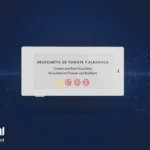The role of digital labeling in F&B: what is not measured in the buffet cannot be improved
Managing a hotel buffet is much more than preparing food for guests: it means planning menus, ensuring clear allergen information, and maintaining a presentation consistent with the brand. A complex operation where every small deviation can impact both efficiency and guest experience.
The biggest challenge for F&B managers is not that incidents occur—because they are inevitable: there will always be last-minute changes or unforeseen events. The problem is not that they happen, but that they are rarely recorded. Without data, they cannot be analyzed or turned into useful learnings to improve operations.
And this is where digital labeling becomes a key tool: it not only communicates with the guest but also enables teams to measure what happens in the buffet and, in doing so, improve their management day after day.
Challenge 1: Last-minute changes in buffet management
An allergen that must be added, a dish that gets replaced, or a translation that needs correcting at the last minute. In the traditional paper signage system, these adjustments leave no trace. The buffet is updated, but the learning is lost.
How digital labeling helps: With Buffetsmart, every update is recorded in the system. This allows managers to detect key patterns in buffet management: which menus change most often, at what times of service adjustments occur, or even which translations generate the most issues.
Example: one day, the dish “huevos revueltos con setas” was mistakenly translated into English as “scrambled eggs with toadstools”. Several guests doubted whether it was safe to eat, and the F&B team had to clarify. With Buffetsmart, that correction is logged, allowing the hotel to adjust its translation dictionary and prevent the same mistake from happening again.
Challenge 2: Deviations in buffet management and their impact on efficiency
When what is planned on the menu does not match what is finally served, the impact is not only visual: it affects operational consistency, can create doubts for guests, and adds pressure on the staff.
How digital labeling helps: With a historical record of changes, F&B managers can identify the causes of deviations (supply issues, forecasting errors, internal communication problems) and anticipate them in future services.
Challenge 3: Making decisions without data in buffet management
Many F&B managers admit they manage their buffet more by intuition than by information. This limits their ability to improve since there is no objective basis for decision-making.
How digital labeling helps: By turning labeling into a source of strategic data, Buffetsmart allows managers to turn intuition into informed decisions. From adjusting purchasing to planning menus more realistically, while also optimizing staff work and increasing F&B efficiency.
Conclusion
In F&B, what is not measured cannot be improved. And buffet management in hotels is no exception.
With Buffetsmart, hotels turn a simple sign into an operational management tool that not only informs the guest but also helps the team gain efficiency, reduce errors, and improve planning.
We know that unforeseen events are inevitable and that eliminating incidents entirely is impossible. The real value lies in using each one to optimize processes and strengthen the guest experience.

👉 Want to see how Buffetsmart can help you optimize your buffet management? Request your personalized demo here.









